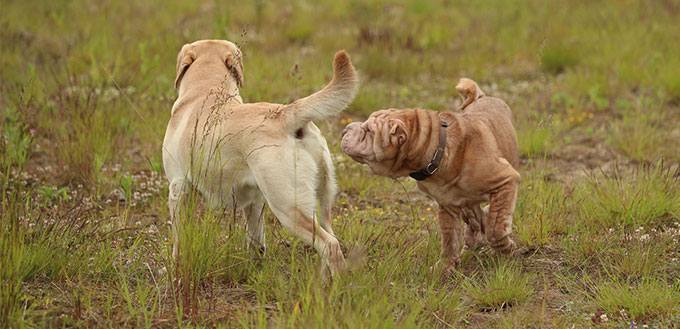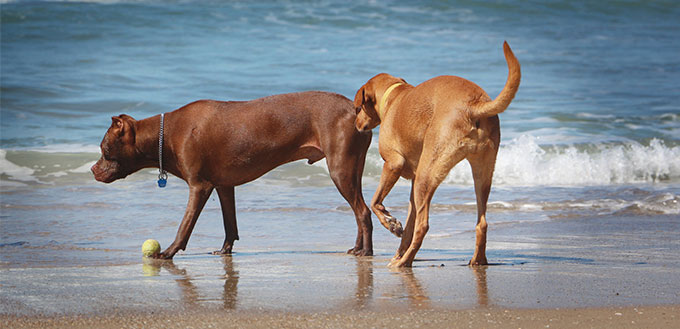Watching your pup sniff another dog’s butt when out walking with you can be quite embarrassing. However, good old Fido is exhibiting the usual canine behavior, which is pretty normal. In fact, it is a thirst for knowledge because dogs get a lot of information about their counterparts by sniffing. But why do dogs smell butts? And should you stop this undesirable behavior as a dog owner? In order to answer this, it is first necessary to understand the dog’s sense of smell and its motivation to sniff. Furthermore, this article details information on the workings of a canine’s olfactory system and the benefits of butt-sniffing in dogs.
How a Dog’s Olfactory Works
In the same way as humans, canines are equipped with five essential neurological senses: touch, taste, sight, hearing, and of course, smell. However, the sense of smell is more pronounced among the canine population as it is many times more advanced relative to that of humans. The difference becomes more glaring when you compare a human’s olfactory receptors, which are five million in number, to that of a dog that has 150 million. In addition, a pup devotes up to 1/3 of its brain mass to odor identification and detection, while only five percent of a human’s brain mass is utilized for olfactory functions.
A dog’s smell detection mechanism is facilitated by two distinct parts, the sensitive nose, in addition to the Jacobsen’s organ. These two organs join forces to provide subtle responsiveness that neither of them is capable of achieving alone. A dog’s Jacobsen’s organ opens up whenever it flares its nostrils and curls its lips – this functions to boost exposure of the canine’s nasal cavity to scented molecules and basically turns into an extraordinarily effective smelling machine.
Why Do Dogs Smell Other Dog’s Butts?
No doubt, dog parents all over the world are perplexed with this canine behavior. Why must it be the butt? Why not other parts of the anatomy like the paws or mouth? The answer to this question is quite anatomical – A dog’s rectum has a couple of tiny anal sacs known as anal glands, which are equipped with a pair of small openings, through which they secrete some toxic smelling matter. Naturally, the glands get emptied through bowel movements upon the contraction of the rectal sphincter muscles. It is difficult for dog parents to be aware of this particular occurrence in dogs since the foul odor of their pup’s poop does a good job of masking the smell of its anal glands. But the story is different for the canine population as their sense of smell is well equipped to distinguish between the two.
A dog’s Jacobson’s organ, located within their nasal cavity, allows them to ignore the odor of stool in favor of those chemical secretions, while they smell the butt of another dog. The organ opens up at the back of the pup’s upper incisors towards the mouth’s roof. This specialized organ is what the dog uses in detecting the chemical secretion from the anal glands. By sniffing this secretion, canines learn many things about each other – from smell alone, dogs are able to distinguish the different sexes, the kind of food another dog consumes, its age, its current mood, and if it is healthy or not. This chemical also aids a pup in determining whether it has met a dog before or not. Equipped with all this knowledge, the dog will know the best way to approach another – this is a typical example of how canines get to know themselves!
One very important function of the Jacobsen’s organ is that it is in constant communication with that part of the canine’s brain that handles issues relating to mating. It identifies pheromones, thereby providing both female and male pups with the information needed to establish things like availability for breeding with dogs of the opposite sex. The organ also functions to boost the sense of smell in a puppy, which aids it in locating the source of its mother’s milk. Even when there are other nursing mothers around, a newborn will be able to pick out its mother by a mere sniff.
Other Benefits of Dog Butt-Sniffing
Calming mechanism: Another benefit that comes from butt sniffing is the calming effect it has on canines. The performance of this inborn ritual functions as some sort of stress reliever, as it soothes the dog. Besides, sniffing can be accomplished faster than a drawn-out conversation. Though this act may seem nauseating to you, try to view it as a socially acceptable way of communication among the canines! Your dog just leverages the sniffing habit to satisfy that urge to take action on a stressful situation.
Enjoyment: Butt sniffing actually smells good to dogs. What’s more, it is both fun and stimulating.
Should This Behavior Be Encouraged in Dogs?
If the two dogs involved happen to be well-socialized, healthy, and tolerant, then you should allow them to sniff it out to their heart’s desire; however, close supervision is recommended. This reduces the possibility of the two dogs breaking out in a fight. However, we have seen situations where one dog wants to get quite intense with the sniffing act, while the other wants to maintain its personal space. This kind of situation may result in hostilities that may cause both dogs to fight. A pet parent’s best course of action is to keep a tab on each dog’s body language; their behaviors will tell you how to handle the situation. This way, you will know when to separate the two dogs and when to allow them to continue with the act.
Sources:
- Kristen Hall-Geisler, Why Do Dogs Sniff Each Other’s Butts?, HowStuffWorks
- Ryan Llera, BSc, DVM, Why Dogs Sniff Rear Ends, VCA Hospitals









